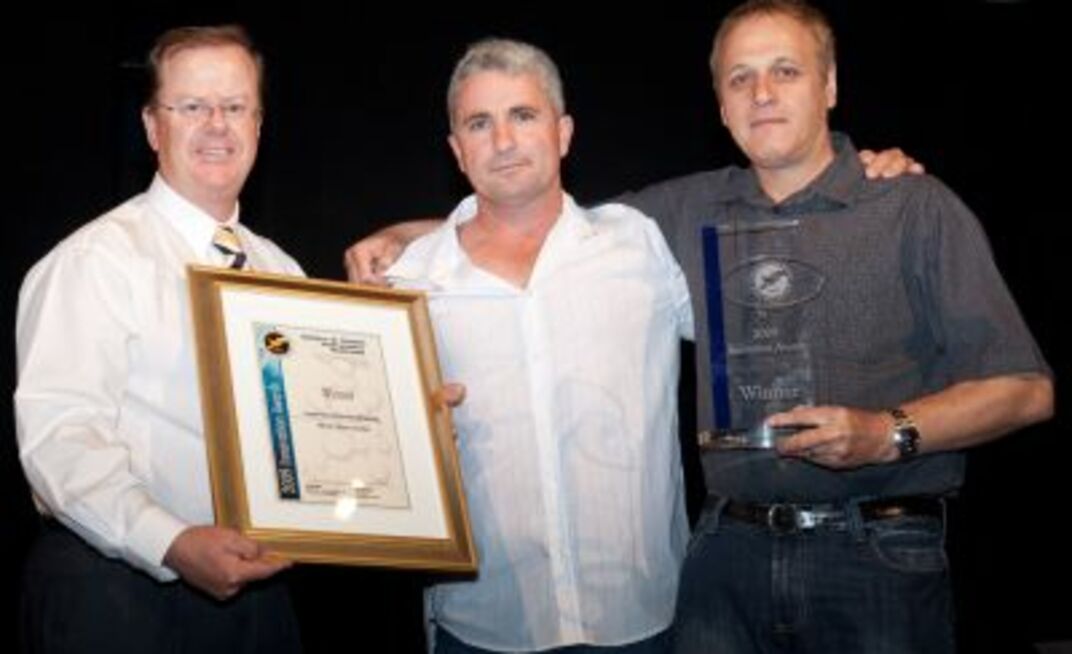The longwall bootend conveyor belt guarding this week beat out 44 entries to win the 2009 Queensland Mining Industry Health and Safety Innovations Award.
The team from BMA’s Gregory Crinum mine was made up of Mike Nesbitt, Andrew Kruger, Eddie Booth, Peter Smitt, Mick Parsons and Brad Stewart.
Their initiative was to develop a hard barrier between the operator and longwall miner conveyor belt system, to allow operators to walk safely past the conveyor belt.
The safety risk became evident to the Crinum team while assessing the current method used for providing protection, when the belt structure at the inbye end of the conveyor belt directly in front of the track-mounted belt bootend was removed.
When this structure is removed it leaves a gap between the last bay of structure and the bootend. The potential for someone to fall into the belt system in this area is high and a guard is required to prevent this from happening.
The accepted method had been to use a flexible plastic mesh, standing about 1m high and about 30cm from the floor, which is retained on a spindle fastened on the bootend and can be unwound and secured at the last bay of structure to act as a barrier.
This method was used at the mine until the crew came up with the concept of running a rigid mesh barrier suspended on extended arms from the monorail rigid trays.
The initial concept was proved, developed and supported by the longwall management team and a prototype was built and trialled.
Macquarie Manufacturing assisted with the development of the project and the manufacture and supply of the guarding system.
All stages of the development were run past the operators for their continual feedback to ensure the guarding was acceptable before manufacturing.
The team faced several challenges in designing the guarding. It had to be light enough not to put undue stress on the rigid sections of the monorail. It also needed to allow for the removal of four bays of structure without having to be dismantled. In addition, it needed to be vertically and horizontally adjustable so that it did not come into contact with the floor or belt structure.
A lightweight monorail system was devised that allowed the guard to move and permitted access to the structure, overcoming the need for dismantling.
To accommodate the removal of up to four bays of structure, a double monorail system was constructed, cutting the length of the monorail by half and allowing the guard to be opened and closed like curtains.
To allow for the undulations of the floor there are two means of adjustment: chains at the top of the monorail attached to the cross members, and a 200mm section at the bottom of the guard sections that can be lowered or raised.
The outrigger cross members have incremental holes along their length that allow for any horizontal adjustment required.
The Gregory Crinum team wasn’t the only winning BMA team at the awards – the Saraji mine won the People’s Choice Award for its feeder blockage removal device.
This team was made up of Shane Phillips, Glen Althaus, Glenn Deaves, Matt Boswood, Dave Kilpatrick, Warren Borg, Max Fraser and Bob Eldridge.
The team developed an engineering solution which makes unblocking feeders much safer.
The device is a high-pressure, water-based lance, which has been fitted to all feeders at the mine.
It can be activated from outside the tunnel, reducing the need for people to directly access the area.
In addition to Gregory Crinum and Saraji, Goonyella Riverside was one of 10 award finalists with its dipper trip system improvement project.

























